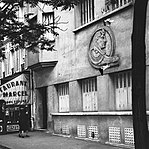Théâtre de la Gaîté-Montparnasse
Buildings and structures in the 14th arrondissement of ParisTheatres in Paris

The Théâtre de la Gaîté-Montparnasse is a venue situated at 26, rue de la Gaîté, in the Montparnasse quarter of Paris, in the 14th arrondissement. It opened in 1868 and seats 399 people. In addition to functioning as a popular café-concert venue for many decades, it evolved into a legitimate theatre, offering not only commercial plays but also, by the end of the nineteenth century, occasional new experimentalist plays of the Independent Theatre movement. One such effort was Paul Fort's Théâtre d'Art disappointing presentation, on 5 February 1892, of a French translation of Marlowe's The Tragical History of Doctor Faustus.
Excerpt from the Wikipedia article Théâtre de la Gaîté-Montparnasse (License: CC BY-SA 3.0, Authors, Images).Théâtre de la Gaîté-Montparnasse
Rue de la Gaîté, Paris Paris (Paris)
Geographical coordinates (GPS) Address Website External links Nearby Places Show on map
Geographical coordinates (GPS)
| Latitude | Longitude |
|---|---|
| N 48.839305555556 ° | E 2.3230555555556 ° |
Address
Théâtre de la Gaîté-Montparnasse
Rue de la Gaîté
75014 Paris, Paris (Paris)
Ile-de-France, France
Open on Google Maps










